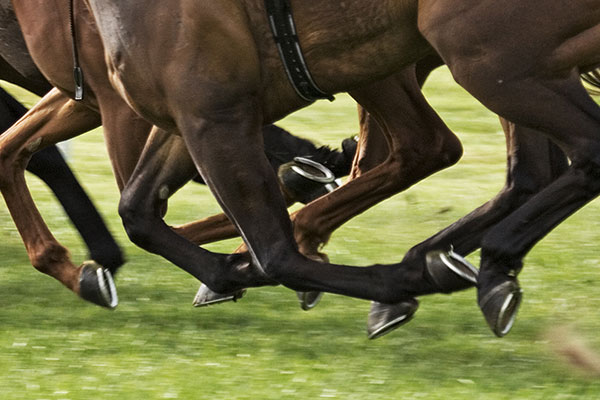Media release 1 June 2022
Download this media release here.
The Victorian Jockeys’ Association (VJA) is backing research for a cure for spinal cord injury, with a generous donation this week to SpinalCure, Australia’s leading funder of cure-related research for spinal cord injury.
“Spinal cord injuries can happen to anyone of any age and they can be devastating both for the person injured and their families,” said Matt Hyland, CEO, VJA. “We’ve also seen spinal cord injuries within our jockey cohort, some of which have sadly been career ending.
“The Victorian Jockeys’ Association through our members are pleased to be able to support the important research SpinalCure Australia are undertaking, and we’re looking forward to working together to help progress towards a cure,” said Mr Hyland.
SpinalCure’s research projects include Project Spark, which aims to transform the lives of people with spinal cord injury with one of the world’s most promising treatments, spinal cord neurostimulation.
“Even small improvements could make a huge difference to people’s lives, and we believe this research has the most promise of achieving that in the next 5 years,” said Kathryn Borkovic, SpinalCure CEO.
“In 2021, we commenced the eWALK clinical trial aiming to help paraplegics walk again.
“We will be expanding this trial through community studies across most states of Australia starting this year, addressing a range of spinal cord injuries and bodily functions.
“With the support of the VJA, our ambassador Edward Cummings and others within the racing industry, there is a real groundswell of support for this potentially life-changing research,” Ms Borkovic added.
Jamie Kah, who is currently one of the world’s top ranking female jockeys, said, “I know I speak on behalf of all Victorian jockeys in saying I’m so pleased our Victorian Jockeys Association is committed to providing meaningful financial support to SpinalCure Australia.
“On behalf of the entire jockey group, I congratulate SpinalCure Australia on their amazing work and hope that one day soon, we will see a cure for spinal cord injury,” she said.
“As a current member and Director of the VJA I am pleased that we are able to make a contribution to Spinal Cure research that in turn may improve the quality of life for jockeys who have unfortunately suffered spinal injuries whilst riding,” added jockey Damien Lane.
To find out more about SpinalCure’s research visit spinalcure.org.au
-ENDS-
About SpinalCure
SpinalCure has been Australia’s pioneer and leader in the funding and promotion of cure-related spinal cord injury research for 25 years.
Three SpinalCure Directors live with a spinal cord injury and know what it requires physically, mentally and emotionally to cope with such a devastating condition. The Board and leadership team also includes leaders in neuroscience, pharmaceutical and medical devices and delivery of health services to injured patients.
SpinalCure identifies, funds and promotes the most promising, cure-focused medical research. Projects are reviewed by a scientific advisory panel consisting of national and international experts in the spinal cord injury field.
Find out more at spinalcure.org.au
About the Victorian Jockeys’ Association (VJA)
The VJA looks out for the best interests of Victorian Jockeys. The VJA collaborates with Clubs and Racing Victoria on behalf of Victorian Jockeys to interpret and implement policies and procedures, working conditions, health and wellbeing, licensing, financial and regulatory matters. The VJA provides career development support to Victorian Jockeys and career transition for Jockeys recently retired, approaching retirement or otherwise likely to be forced from the industry due to injury or other issues such as increased weight with the Career Transition Program.
Background
Spinal cord injury key facts
Whilst there are no reliable statistics currently available about racing and spinal cord injury, we do know that because of the speed the rider is travelling and the height from which they fall, spinal cord injury is a risk for jockeys.
- Every day, someone in Australia injures their spinal cord, with devastating consequences.
- There are over 20,000 people in Australia with spinal cord injury.
- These injuries disproportionately affect young people at the prime of their lives
- There is currently no cure or treatment available.
- Spinal injury costs the Australian economy $3.75 billion per annum with a lifetime cost in 2020 estimated at $75 billion.
- For a comparatively small investment, we can make a significant impact on people’s lives and save on the substantial costs to the economy.
- Cost savings from recovery in just 10 percent of people are conservatively estimated to be $3.5 billion, with the potential to be as high as $10.3 billion.
- In a second, someone’s life can change: from a car or sporting accident, or a simple fall. Any one of us could go from being active to injuring our spinal cord and spending much of their life in a wheelchair.
- The impact is life-shattering, not only for the injured person but also for their loved ones.
- For these people, there is currently no treatment, pill or lifestyle change that can mitigate the effects of a spinal cord injury. Research is their only hope.
- Loss of movement is just the tip of the iceberg—ongoing pain, digestive health issues, pressure sores, spasm, loss of bladder and bowel control and impaired sexual function are just some of the effects that can make everyday life so difficult.
- Increasing the independence of people with spinal cord injuries through improved treatment would substantially reduce the $3.7 billion annual cost to the economy by:
- reducing care requirements through increased independence;
- reducing rehospitalisations for such things as urinary tract infections, digestive issues and cardiovascular complications; For more information visit: spinalcure.org.au/research/spinal-cord-injury-facts/
- improving physical and mental health, and increasing workforce participation by people with SCIs.

